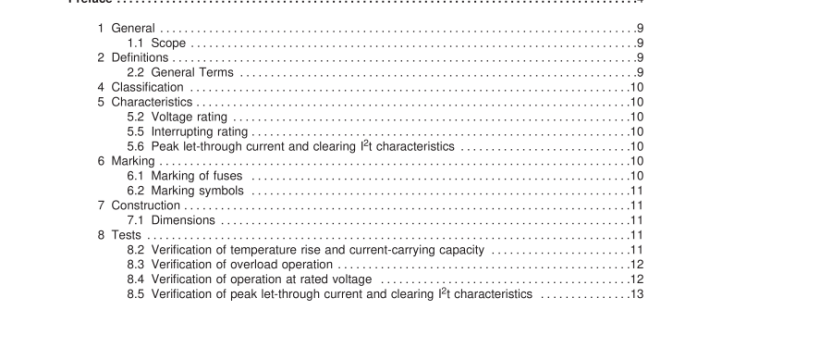UL 248-13-2010 pdf download.Low-Voltage Fuses – Part 1 3: Semiconductor Fuses.
1 General NOTE – This Part is intended to be read together with the Standard for Low-Voltage Fuses – Part 1 : General Requirements, hereafter referred to as Part 1 . The numbering of the Clauses in this Part correspond to like numbered Clauses in Part 1 . The requirements of Part 1 apply unless modified by this Part. For Clauses not shown below, refer to the Standard for Low-Voltage Fuses – Part 1 : General Requirements, NMX-J-009/248/1 3-2000-ANCE ♦ CAN/CSA C22.2 No. 248.1 ♦ UL 248-1 . 1.1 Scope This Part applies to semiconductor fuses rated 2000 V ac or less. DC ratings are optional. Note: The Canadian Electrical Code, Part I, defines low voltage as any voltage from 31 to 750 V inclusive and high voltage as any voltage above 750 V. The National Electrical Code, NFPA 70-1 996 , Section 71 0-2 defines high voltage as more than 600 V, nominal. 2 Definitions 2.2 General Terms 2.2.1 5 Semiconductor fuse A fuse, letter designation ″R,″ intended only for protection or isolation of semiconductor devices such as SCR’s, diodes, and the like, and not branch-circuit protection. 2.2.1 5.1 ″g″ Fuse A fuse capable of interrupting under specified conditions all currents which cause melting of the fuse-element up to its interrupting rating. 2.2.1 5.2 ″a″ Fuse A fuse capable of interrupting, under specified conditions, all currents between the lowest current specified by the manufacturer and its interrupting rating.
4 Classification Semiconductor fuses are non-renewable. They shall provide short-circuit protection and may provide overload protection. gR – Full-range, overload and short-circuit protection. aR – Partial-range, short-circuit protection. 5 Characteristics 5.2 Voltage rating For AC, the rating shall be 2000 V ac or less. The DC voltage rating may be different from the AC rating. 5.5 Interrupting rating For AC, the preferred ratings are 25,000, 50,000, 1 00,000, or 200,000 A. For DC, the preferred ratings are 20,000, 50,000, 1 00,000, 1 50,000, or 200,000 A. 5.6 Peak let-through current and clearing I 2 t characteristics Maximum values of peak let-through current and clearing I 2 t are provided by the manufacturer. See Clause 8.5.3. 6 Marking 6.1 Marking of fuses In addition to the marking requirements in Part 1 : A semiconductor fuse shall be marked with: e) the fuse class or classification (See Clause 6.2): gR (Full-range); or aR (Partial-range); and g) the marking ″Current Limiting″ may be applied if the fuse complies with the threshold ratio test.
8.3 Verification of overload operation For gR fuses, the overload operation point and maximum opening time shall be specified by the manufacturer and shall be selected from the following values: 1 35, 1 50, 1 60, 1 75, 200, or 250 percent of rating. For fuses rated less than 600 A, two samples are to be tested. For fuses rated 600 A and greater, one sample is to be tested. 8.4 Verification of operation at rated voltage AC – Part 1 , Table 5 Test 1 – High current specified by manufacturer Test 2 – Maximum energy Test 3 – Threshold ratio. Required for fuses marked ″Current Limiting.″ The maximum threshold ratio shall be specified by the manufacturer. Test 5 – Test to be conducted at a low current specified by manufacturer. Shall not be greater than 800 percent of the fuse current rating, I n , test current tolerance +0% – 1 0%. Notes: a) peak let-through current and clearing I 2 t recorded during Tests 1 and 2; b) test circuit frequency shall be recorded; and c) the maximum peak arc voltage is specified by the manufacturer. For DC – Part 1 , Table 6 Test 1 – High current specified by manufacturer Test 2 – Maximum energy Test 5 – Test to be conducted at a low current specified by manufacturer. Shall not be greater than 800 percent of rating, I n test current tolerance +0% – 1 0%.UL 248-13-2010 pdf download.
UL 248-13-2010 pdf download
